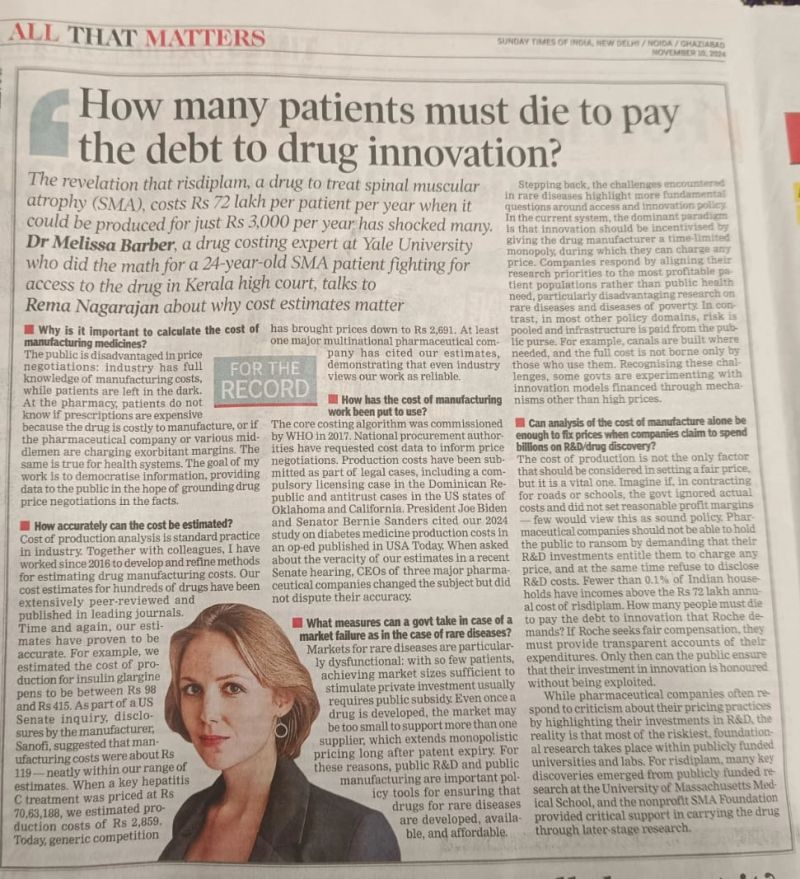How Many Lives Are at Stake? The True Cost of Drug Innovation and Access to Life-Saving Medicines
"Are high drug prices justified by the cost of innovation? Explore the complex reality of drug pricing, R&D costs, and how many patients pay the price with their lives."
When I first learned that risdiplam, a drug for spinal muscular atrophy (SMA), costs an unimaginable ₹72 lakh per year while it could be produced for just ₹3,000, I felt a wave of shock. How can something so essential be so out of reach for so many? This story isn’t just about numbers—it’s about real people, often children, fighting for their lives. Dr. Melissa Barber, a drug costing expert at Yale University, recently spoke out on this topic, highlighting the critical need for transparency in drug pricing. Her research could help us understand why medications like risdiplam come with such high price tags. But is this justifiable, or is it time for a reevaluation of how we incentivize innovation?
(For a deeper dive, check out Dr. Barber's interview in the Times of India.)
The True Price of a Miracle Drug
The story of risdiplam raises a troubling question: How many patients must pay the ultimate price before drug prices become fair? As Dr. Barber explains, while drug companies claim their pricing reflects high R&D costs, the reality is often far more complex. Many groundbreaking discoveries actually begin in publicly funded research labs, not in the labs of big pharmaceutical companies. For example, risdiplam’s development was supported by research from the University of Massachusetts Medical School and furthered by the nonprofit SMA Foundation. Yet, the final product is priced beyond what almost anyone can afford.
Pharmaceutical companies do invest heavily in research and development, and yes, some of that investment is high risk. But if public funding helps develop a drug, why should the public then pay a premium to access it? The pharmaceutical industry’s response typically centers on the high risk and expense of R&D. But transparency is lacking; very few companies disclose exactly how much of their costs are truly spent on research, versus marketing and profit.
Why Does Cost Transparency Matter?
Imagine walking into a pharmacy with a prescription for a life-saving drug, only to find out that it costs as much as a luxury car. You’d likely ask, “Why is this so expensive?” Dr. Barber’s work centers around answering this question. She and her team have developed methods to estimate drug manufacturing costs—methods that have been rigorously reviewed and validated. Surprisingly, even some pharmaceutical companies now recognize the reliability of her estimates.
Why is this transparency so essential? Well, without knowing the true cost of production, patients and healthcare systems are at a disadvantage in price negotiations. Imagine if the government negotiated the price of infrastructure without knowing actual costs—few would see that as sound policy. Yet, with drugs, this is the norm.
Unpacking the “Debt to Innovation”
Pharmaceutical companies argue that their high prices are a “debt to innovation,” justifying the high prices of new drugs because of the immense investment involved in research and development. But here’s the catch: much of the groundbreaking science behind these drugs is done in publicly funded labs. For instance, many of the foundational studies for risdiplam were conducted in publicly funded institutions. If taxpayers are footing part of the R&D bill, it’s only fair that they shouldn’t be priced out of the resulting medicines.
In the case of rare diseases like SMA, the stakes are even higher. With fewer patients, pharmaceutical companies often charge higher prices to make up for the smaller market. However, this approach has serious implications: people who need the drug most can’t afford it. And so, the very people who are supposed to benefit from innovation become its casualties.
Alternative Models: Is There a Better Way?
Countries worldwide are beginning to explore alternative models that prioritize patient access over profit. For instance, some governments are experimenting with funding drug innovation through public investment, rather than allowing monopolistic pricing. This approach could ensure that life-saving drugs are accessible to all, regardless of income. Imagine if we treated healthcare infrastructure the way we do public services—financed not by those who can afford it, but as a communal investment in the well-being of society.
How Many Patients Must Die?
One of the most haunting questions Dr. Barber poses is: “How many people must die to pay the debt to innovation?” If a company like Roche, which manufactures risdiplam, seeks fair compensation for its product, then it should be transparent about its costs. Fair pricing is possible, but it requires that companies disclose their actual expenditures on R&D and manufacturing.
What Governments and Patients Can Do
So, what can we do as individuals and as a society to change this? Here are some actionable steps:
Support Transparency in Drug Pricing:
Advocacy for transparency in drug pricing can help ensure that the prices of medicines are based on their real production costs, not inflated margins.
Push for Public Funding Models:
Public health advocates can campaign for models that pool the financial burden of drug development across society. This could reduce monopolistic pricing and make essential drugs more accessible.
Demand Accountability:
Support legislative efforts to hold pharmaceutical companies accountable for their pricing. In the U.S., for example, lawmakers like Bernie Sanders have demanded transparency around insulin pricing.
Educate and Raise Awareness:
By staying informed and sharing knowledge about these issues, we can shift public perception and pressure pharmaceutical companies to adopt fairer pricing practices.
The Real Cost of Healthcare Inaccessibility
When life-saving drugs are priced out of reach, patients pay the cost with their lives. While the pharmaceutical industry insists on high prices to “pay back” the cost of innovation, it’s crucial to remember that many of these innovations come from taxpayer-funded research. This means that patients are essentially being asked to pay twice: first, by funding public research, and then through high drug prices.
As I reflect on this, I feel a mix of frustration and hope. Frustration, because life-saving medications should be a right, not a luxury. Hope, because conversations around drug pricing transparency are growing louder. Advocates like Dr. Barber and organizations pushing for fair drug pricing are giving a voice to those who’ve been left behind by the current system.
Conclusion: A Call for Change
Ultimately, fair pricing isn’t just about numbers—it’s about dignity and accessibility. It’s about ensuring that everyone, regardless of their economic status, has a chance to live a healthy life. The fact that risdiplam could be produced for as little as ₹3,000 but is priced at ₹72 lakh exposes a glaring gap in our healthcare system. And while this gap may seem insurmountable, each conversation, each piece of advocacy, and each step toward transparency brings us closer to a world where healthcare is accessible to all.
As we continue to navigate these complexities, we owe it to ourselves and future generations to push for transparency, fairness, and accountability in drug pricing. Innovation is essential, but it should never come at the cost of human lives.

Credit to Dr. Melissa Barber and the Times of India for valuable insights.




What did you think of this article?
We value your feedback and would love to hear your thoughts on this article.
Write to: hello [at] watchdoq [dot] com with questions or comments.
Additional Resources